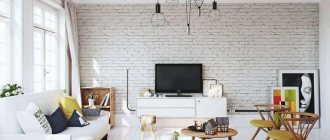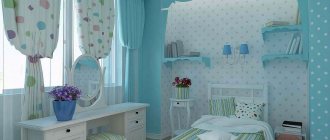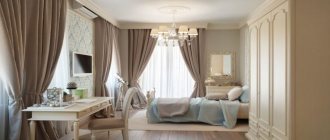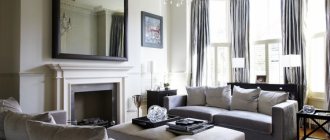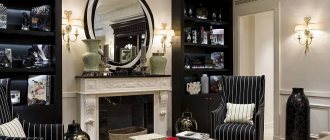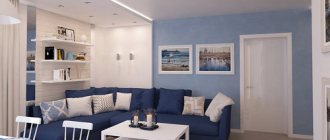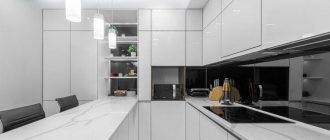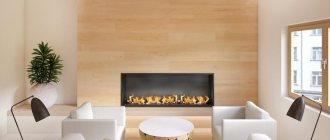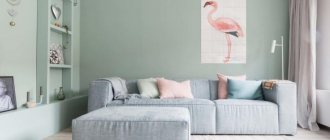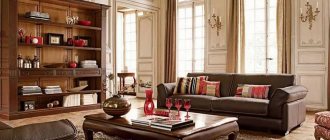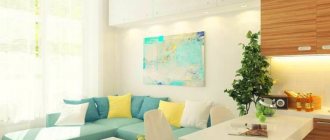Home » Decor » Wall decoration
DesignWall decorationInterior styles
Belyaeva Irina
61846 Views
A brick wall in the interior allows you to add zest to the design of your home in an affordable way. Highlighting a wall with brickwork allows you to create unusual, stylish and elegant interiors. Brick makes it possible to decorate a space in the most effective and original way. Everything will be discussed in more detail later in the article.
History and modernity
Brickwork in interior design has gained popularity thanks to lofts. Initially, the former factory premises were given to poor tenants who could not invest in a full renovation with plastering and painting.
This is how raw walls, which can be seen in old photos, came into fashion. Students and young families not only lived in such premises, but also held noisy parties with the participation of guests from various social classes.
This new direction in design became associated with bohemianism, industrialism and freedom, which appealed to city residents. Nowadays, brick wall decoration is again very popular, and can be used in combination with various styles.
You can also achieve an appearance that imitates brickwork using 3D wallpaper from picwalls.ru
Snow-white brickwork
Stencil, graffiti, painting
If you want to show your imagination when decorating the walls, you can choose one of the painting options below:
- Stencil. This painting technology involves highlighting part of the wall with color. This could be a geographical map in the living room, a geometric pattern or a motivating slogan. The blank is cut out of whatman paper or thin plastic. It is better to choose paint that contrasts as much as possible with the shade of the brick.
- Graffiti. It will look especially interesting in a loft interior or a nursery for boys.
- Hand painted. Images are painted using acrylic paints. The theme and application technique in this case are limited only by the imagination and skills of the artist.
Advantages and disadvantages
Any finish has its strengths and weaknesses. Let's get to know them before we start implementing our ideas.
Advantages: accessibility and simplicity
The undeniable advantages of using brick in the interior include:
- Financial inclusion.
- Safety.
- Naturalness.
- Good performance properties of the material (sound insulation, thermal insulation, moisture resistance).
- Ease of finishing. The design process using bricks allows you to cope with the task even without special skills and complex tools.
- You can use this approach in arranging almost any room.
- A brick wall can perform not only a decorative, but also a practical function - serve as a delimiter between rooms.
- Possibility to use hanging elements - shelves, lighting fixtures, TV, etc.
- Additional surface treatment is not necessary.
- Possibility of masking wall defects.
- Originality.
- Durability.
- Texture.
- Good compatibility with natural colors and natural materials.
- Decorative finishing.
Additional wall treatment is not necessary
Disadvantages: the main thing is to stop in time
There are quite a lot of advantages to this type of finishing. But what are the disadvantages?
The disadvantages of a brick wall in the interior of a house include:
- Untreated natural-colored brick needs high-quality lighting. As an alternative, you can use white brick or paint it.
- An uneven textured surface is difficult to clean.
- Too much brick in the interior design of a house can create the effect of an unkempt and cold room that lacks coziness.
An uneven surface is more difficult to maintain
The brick wall should be an original accent, and not occupy all the walls.
Color design of a brick wall
Due to its texture, brick looks impressive on its own, but its natural shade is not suitable for every interior style. In this case, it is worth resorting to painting - this way the masonry can be given any color.
Painted brick wall in the interior
Working with paint
Before painting the wall, remove all dirt from it (see how to do this above) and wait for it to dry completely - after wet cleaning it is better to wait a couple of days. If the masonry has deep cracks, and you want to achieve an even coating, all chips must be filled with plaster, and after it has dried, the surface must be sanded with sandpaper. Then you need to coat the brick with a primer designed specifically for this material.
Painted white brick wall in home decor, photo by Koen Van Damme
When choosing a paint, pay special attention to whether it is suitable for interior decoration. Compositions intended for facades may contain toxic substances, so they are unsafe for interiors.
White painted brick wall in the kitchen
After the primer has dried, you can begin painting. Protect all necessary areas (floor, ceiling, door and window openings) with masking tape, then begin applying paint with a roller or brush, moving from top to bottom.
Painted brick in the fireplace portal area
Painted yellow brick wall in room design
Black painted brick wall in the bedroom
In order for the paint to completely cover the original shade of the brick, you will need to apply at least 3 layers. This does not depend on the color of the paint: white, gray, black or bright colors - in any case, you will have to cover the surface several times, after first waiting for the previous layer to dry. Also remember that a brush gives a denser and more even finish than a roller, but also takes more time.
Decorating a brick wall with white paint
Gray paint for decorating a brick wall in the interior
Green brick wall in the bathroom interior
Aged whitewash effect
In Scandinavian interiors and loft-style rooms, a brick wall with an imitation of “crumbling” old whitewash looks great. This effect can be achieved using white paint diluted with water. Mix water and paint in a ratio of 1:3 and simply cover the masonry with this composition as with regular paint (see above). When the surface dries, characteristic stains will appear on the wall, and individual blocks will remain not covered at all - this solution will look very stylish and unusual.
Whitewash effect on a brick wall in the interior
Decorative brick wall with whitewash effect in the interior
The more water in the solution, the more “vintage” the effect will be: experiment with proportions on a small area before covering the entire wall.
Decor with a whitewash effect for brick walls, photo by Olga Melekestseva
Imitation of aged whitewash on a decorative brick wall
Stain coating
If you want to darken the shade of the brick by several tones without radically changing its color, you can cover the masonry with a regular wood stain. The technology here is no different from working with wooden surfaces: apply stain to the wall and let it dry for several hours (the exact drying time is usually indicated on the packaging of a particular product). This technique will give a vintage mood to the brickwork, and with it to the entire interior of the room.
Coating with stain makes a brick wall a little darker
Darkening a brick wall with wood stain
Darkening a brick wall with wood stain
Real masonry or imitation: what to choose?
In addition to using real brick, its imitation, wallpaper of suitable colors or tiles of appropriate stylization can be used.
Real brick wall
In this case, the masonry made from floor to ceiling is not subject to additional plastering or hiding under sheets of plasterboard. For a spacious room with high ceilings, one of the walls of the room can be left without additional covering.
Made from real brick
But processing must be present:
- The masonry is cleaned of dust and solution residues.
- They wash.
- Grinding.
- The joints are rubbed using putty or grout.
- Possible varnishing or painting.
Decorate the living room to your taste
Wallpaper with print
The simplest and most financially uncomplicated way of decoration is wallpaper with a corresponding pattern. The effect of masonry can be created not on the entire wall, but only on certain areas, for example, niches or wall fragments. Wallpapering can be combined with other decorative materials:
- decorative putty;
- natural wood;
- tiles.
Wallpaper with a pattern
Attention should be paid to the selection of colors and expressiveness of texture. The best effect is created by high-quality design material. Separately, it should be noted that the textured wallpaper can be painted. You can even give them the desired shade yourself.
High-quality wallpaper that imitates brick can be used in places that are inconvenient for decoration with other materials:
- narrow niches;
- on surfaces that have a bevel;
- on uneven surfaces, etc.
Excellent imitation
Advice A wide field for realizing ideas is provided by photo wallpapers that combine a “brick” background with another print, for example, graffiti.
Facing brick
Facing materials are currently presented very widely. It is lighter and thinner, compared to standard brick, takes up less free space and has a low weight . This circumstance allows the use of this facing material for finishing thin walls and in cases where it is important to economically manage free space.
The material can be:
- artificially aged;
- matte;
- treated with glaze.
Cladding materials are very popular
Brick-like tiles
Brick veneer has an even thinner thickness compared to facing bricks. Tiles can be of two main types:
- clinker;
- ceramic.
Before laying, the wall surface must be pre-leveled.
Interior design element
Independent production of cladding material
In addition to the listed options, imitation brick can be made independently. This requires molds, varnish and brick plaster. This option can be used if you need to create an unusual design using bricks of a non-standard format.
How to make a brick wall: manufacturing and painting technology
Before you start work, you should decide on the design. Finishing in the form of brickwork can be done in various ways:
Before starting work on installing decorative bricks, it is worth marking the wall according to the intended design
- fragment;
- as an accent;
- the whole wall;
- in the form of a decorative element.
If partial finishing is required, a small area of the surface is covered with brick. This method allows you to emphasize the solidity of the walls of a living space.
Interiors using brickwork look especially interesting and unusual
Helpful advice! It is advisable to use fragment design to create an interior in a Scandinavian style.
Wall with imitation brickwork as an accent in the living room interior
Using an accent, you can highlight a certain part of the wall that requires special attention. This method is most often used to advantageously play up the central objects of the interior:
- area around the fireplace;
- the wall located behind the head of the bed;
- area where a TV is installed, etc.
To highlight a separate part of the room, which has the main semantic load, an entire wall is decorated. In the living room this method is used to highlight the sofa, in the kitchen - the dining area, in the bedroom - the bed.
Using bricks you can make individual architectural details. Such an element can be a section of a wall located separately, an arch or a bar counter.
How to create an imitation brick wall with your own hands
Having determined the key points of the design, you can begin to create a finishing material to imitate masonry. To make bricks, you will need a special mold for pouring and a coloring composition. Experts advise using transparent varnish and brick plaster for this. A polyurethane mold for pouring can be purchased at a store or made independently from plastic. The main thing is that it has the appropriate size and shape. And the size of the bricks can be different, as long as they remain rectangular.
First, in accordance with the instructions, you need to prepare a gypsum mixture. It is then placed in a pouring mold and left to dry completely. After making sure that the bricks have frozen, you can take them out. The finished elements are fixed to the wall using glue intended for laying tile products. To get a more realistic effect, you can partially break the edges of some bricks. The thickness and size of the elements is selected at personal discretion.
To create facing bricks, a special gypsum mixture and molds are used
Visual effects: how to influence the perception of space?
A wall made of traditional red brick is not the only possible option. The texture of the material and the laconic form of individual elements allows you to influence the perception of space. How to do it?
White wall
This option is used so often that it requires separate mention. Texture combined with white creates a good background for placing bright accessories.
White wall in the kitchen
The versatility of the shade allows it to be used in any room as the main design or to highlight individual zones. In white it is even possible to decorate all the walls in the room.
And at the same time the room will not look gloomy and basement. On the contrary, a light shade “adds” free space, making the room visually larger. Most often this technique is used when decorating bedrooms and kitchens.
Looks good in any room
Painting it white makes the design modern and dynamic.
Living room
The name of the style with brick walls is not so important as the fact that you can use aged, facing or clinker bricks in the design of any room. In order for the interior to be thought out, and for the brick wall to fit into the overall atmosphere of the house and become its highlight, it is necessary to approach the task correctly. Living rooms have long been a common place where you can find a brick wall. The living room is the space that unites everyone in the house. You get together with guests, have fun, watch TV, read or just relax. Can a brick wall become a warm and cozy element in your living room decor? The right brick choice, size and placement will help create a completely new look for the room that will add character and an interesting look to the space as a whole.
A brick wall can be an excellent backdrop for elegant furniture, modern household appliances and accessories in the living room interior. A fireplace that can be lined, for example, with gypsum decorative material looks very cozy. It will give you home comfort and warmth. A living room in a Greek style will help highlight the brick columns. They will act as partitions and intriguing decor.
Here is an example of the design of a space designed as a combination of Scandinavian style and loft: a lot of light, natural materials, plants, large windows and dominance of white! You can avoid plants in the bedroom, but grow at least two or three in the living room. They will give life to your space.
A partition made of aged brick will help to delimit the territory of the living room and kitchen.
We combine the incongruous
A brick wall is original, impressive and fashionable. But how can you choose the rest of the design as organically as possible?
Designers advise:
- Very often such a wall combines several shades. In this case, it is better to select furniture using the darkest and lightest colors as a basis.
- The rigor of the design can be enlivened by a bright carpet or eye-catching accents, such as colorful pillows on the sofa.
- Red brick color goes well with orange, yellow, and blue. This combination is especially effective in oriental ornaments.
Is it worth using additional decorations?
There is an opinion that the textured cladding itself is very active and the decor on it only gets in the way. Not at all. Surfaces are decorated with paintings, shelves, art objects, even carpets. It will also be combined with minimalist posters and even mirrors in classic carved frames. Feel free to experiment.
Photo: Instagram loft_interior
Photo: Instagram loft_interior
So, the design solution is actively used both in Russian interiors and abroad, and such finishing can be seen in different styles - not only in a typical loft.
Brick in the living room interior: creating extraordinary effects
Decorating the living room with brickwork allows you to give the room a fashionable touch. The originality of this finish allows you to make the wall the main decorative element.
The larger the space in the living room, the more organic and impressive the brick wall will look. The combination with a light ceiling and wooden ceiling beams will give it style.
Organically fit into the interior
The spirit of antiquity is emphasized by the brick design of the space near the fireplace, the walls between the window openings and even the central wall. In addition to walls, brick can be used in partitions, fireplaces, etc.
Dark brick in the interior must be balanced with light shades. This can be done using furniture, textiles, and accessories.
Dark brick needs to be diluted with light furniture
Tip The presence of a fireplace in the living room can be played up by highlighting a part of the wall near it with appropriate design.
Blackout brick
Vintage interiors with antique furniture, home libraries and offices are often decorated in dark colors. Brick color is no exception. We take into account several ways to give the surface a “smoked” look.
- Stain. The variety of dye colors allows you to experiment with shades, achieving perfect harmony with the style of the room.
- Blowtorch. Small areas of masonry are quickly treated with a soldering iron flame, adding dark spots.
Brick in the kitchen interior: a variety of options
The safety and durability of brick allows it to be used in the interior design of many rooms. In the kitchen it can be used in doses, allowing you to create an accent where it is needed.
Kitchen apron
This wall area is regularly exposed to steam, soot and grease. The apron occupies the space between work surfaces and wall cabinets.
Non-standard solutions
In order to facilitate the cleaning process, designers suggest adding a glass sheet to the exterior of the brickwork . This technique will preserve decorativeness and protect surfaces.
One of the walls
Decorating one of the walls with brick will look most impressive in an interior with a predominance of warm light shades:
- milky white;
- light gray;
- caramel;
- soft pink;
- cocoa shade.
Accentuating one of the walls
Part of the wall
Selecting a fragment of a wall looks no less impressive. Most often, this design is used for the dining area. In small rooms, this technique will allow you to delimit zones.
Niche
A natural or decorative niche lined with brick will help emphasize the historical orientation of the design, stylization of a rustic design, Provence style, etc. If a niche is formed near the stove, this will add retro touches to the decor.
Option for execution in the kitchen
Advice In addition to the listed options, a column in the room, a partition, a place near the bar counter, etc. can be decorated with brick.
The most successful combinations of turquoise
Turquoise is a difficult color because it is complex. Therefore, you need to combine it with other colors very carefully. Best suited:
- white;
- lactic;
- beige;
- sand;
- brown;
- natural wood color;
- pale pink;
- pale gray;
- dark grey;
- black;
- bright yellow.
Brick in the bedroom interior
Brick in the design of a bedroom can be used to emphasize the character of the finish. Most often, in a bedroom, one wall or an area near the head of the bed is bricked.
Tip To add the sophistication characteristic of Provence or to endow the room with romantic features, painting the brickwork with light paint can be used.
We bring ideas to life
Bedroom
If you choose stone or brick in your home, it will mean that you have impeccable taste, that you like to follow fashion trends in all aspects of life and give preference to high-quality and durable materials. White brick will add charm to a modern bedroom.
In a one-room or two-level apartment, instead of a door to the bedroom, you can make a brick arch. When arranging a room, a brick wall is ideal, no matter what style you choose - Scandinavian, Provence, country or loft.
Brickwork will look very romantic in your bedroom, especially if the headboard is adjacent to such a wall. You can use all sorts of combinations of different surfaces. This will be a pretty creative solution. An example would be the perfect combination of brick and wood.
Avant-garde and romance will be connected in the interior of a bedroom with a brick wall with floral details on bedding and vases with flowers. They will enrich the space and make it look much warmer.
Styles: choosing a design option
Brick is distinguished by its versatility as a finishing material. Its use is most justified when decorating an apartment in the following styles: loft, country, Provence, etc. Such design of vertical surfaces is impressive and relevant.
Loft
Housing organized on the territory of former production premises, workshops or factories is characterized by a large area and high ceilings. These advantages allow you to implement design techniques that are not always acceptable in small apartments. These include wooden ceiling beams, columns, and brick decoration.
Loft style
The loft allows you to leave open electrical cables, heating pipes and other elements that highlight the technical engineering equipment of the house. Bricks are also a suitable backdrop for placing video and audio equipment.
Country
A style that uses natural materials and naturalness in design goes well with the design of country houses. The comfort of simple interiors with fireplaces and natural materials is emphasized by a brick tub combined with wood. This design is associated with relaxation and outdoor recreation.
Country style
Gothic
This trend dates back to the Middle Ages. The Gothic style uses brick in decoration in combination with forged parts of furniture and accessories.
Minimalism
Red brick, brown, white and gray colors should go well with the overall design - ceiling, floor and furniture.
When nothing is too much
Grunge
Mixing several styles and design trends allows you to introduce the most whimsical elements into the interior. The stylishness achieved in this way can become a distinctive feature of your home, and emphasize its dissimilarity with the homes of friends and acquaintances.
Ecostyles
Unity with nature, the use of wood, stone and natural fabrics in the design allows you to create a very cozy home. Brick, with its emphasized environmental friendliness, can become one of the components of such an interior.
We create cozy housing
High tech
Far from the word “ecologically friendly,” urban high-tech can also be combined with brickwork. Most often, imitation tiles are used for it.
Classic English interior
The emphasized rigor of design and correctness of English classics can be combined with brick elements. The touch of aristocracy and style inherent in medieval castles of the English nobility can be accentuated by the use of brick decoration.
Refresh with a light sofa
Loft style
First, it’s worth understanding what the interior style with brick walls is called and where such walls would be appropriate. Without knowing the basic characteristics of a style, it is difficult to follow it.
Industrial design became popular in the 1990s, when old manufacturing plants and warehouses began to be renovated into apartments and office space. Instead of covering up or removing all remnants of the space's industrial design, such as brick walls, exposed pipes and electrical wires, and installing interior walls, architects and designers created large open units that retained the old floors, walls and most of the pipes, wiring and beams. This industrial style is called loft.
Now you know what the style is called when brick walls become the main component of the interior.
Using bricks: tips and tricks
How to preserve masonry and avoid tarnishing and defects?
Real brick is beautiful in itself, has a pronounced texture and a characteristic shade. How to preserve it without losing quality characteristics and color? For this, interior designers advise using special protective compounds.
If there is a lack of light, which occurs, for example, in a hallway, the wall can be varnished with a slight glossy effect. This will ensure color preservation.
In sunny rooms, you can varnish with a matte effect. Such protection will be completely invisible, but at the same time quite reliable.
In an industrial interior
Is old brick good or bad?
The old brick wall looks historic, attractive in its rugged beauty. But for the interior it must first be put in order. For this purpose, brushing is used. You may need to wipe the stained areas with a mixture of vinegar and water.
Advice: Before using aggressive cleaning agents, check the condition of the brick. A crumbling surface cannot be treated this way.
With the effect of old brick
High humidity: how to overcome it?
In rooms where there is often high humidity, such as a bathroom, protecting the brickwork comes first. To do this, the crumbled seams are deepened a couple of centimeters, and then restored with a new solution. The next step is sealing to protect against mold.
Protecting brickwork
Masonry pattern and brick texture on wallpaper
The pattern on the wallpaper can depict large, medium or small bricks of a classic rectangular or almost square shape. It can imitate old or new masonry, which allows you to choose the finishing material in accordance with the style of the interior. So, for example, for an attic, wallpaper with a uniform and smooth imitation of masonry is suitable, and for Provence or country style, bricks of different ages would be the ideal solution.
The higher quality the wallpaper, the closer the texture of the imitation is to the original. Some modern manufacturers of finishing materials add tiny fragments of brick to the canvas. This makes the coating more realistic not only visually, but also to the touch. The relief of brick wallpaper can be improved through correctly placed additional lighting sources.
Work on mistakes
Using such a simple and yet quite complex material, it is necessary to take into account some features of brick:
- Once the wall is painted, it is extremely difficult to remove the paint if necessary. This is due to the porosity of the structure and good absorption.
- It is not advisable to completely highlight a long wall with brick. In this case, it must be “broken” with pieces of furniture, mirrors or decor. This way it will be better perceived visually.
- Mirrors reflecting a brick wall will help unite the space of the room into a single ensemble.
- The paintings look very beautiful on brick walls. The more there are, the more attention is drawn to the wall itself.
- Hanging open shelves hung on such a wall add coziness. Their color and material are selected taking into account the style of the room.
Bright accent
VIDEO: How can you use brick on a wall?
Brick wall
Ideas for your interior
Color shades of turquoise
Despite the fact that turquoise is perceived as a rich color, it can be quite diverse.
The most commonly used shades of this color:
- mint cream;
- sky blue;
- light cyan;
- pang; pale blue;
- pale turquoise;
- aquamarine;
- bright turquoise;
- very dark turquoise.
Each of them is able to create completely different images of walls in turquoise tones.
Application in various rooms
The use of turquoise color in each room of the home is unique in its own way. Taking into account the features of the layout and the existing square footage, these may be different elements of the arrangement or the finishing used. Moreover, for harmony, you will have to pay a lot of attention to the texture and selected design component.
For example, it could be Venetian plaster or textured wallpaper on an accent wall, a stretch ceiling or a small part of it, a wall picture frame or a floor planter.
The choice of color and the degree of its saturation is selected based on the size of the room and the degree of its illumination. This allows you to play up the shortcomings and turn them into the “highlight” of the interior.
Somewhere the turquoise color will be used as an unobtrusive accent, in another case it will become the border of a certain functional area.
In addition, it can be an accessory, a seemingly insignificant part of the design that will bring notes of vitality to the room.
Living room
The living room of any home is a cozy corner where you want to spend time with maximum comfort. This is the best place in the house where you can gain strength, calm down, and relax. However, regardless of the degree of deficiency of inner peace, you cannot fill the entire room with turquoise alone.
This is the wrong approach to creating the right atmosphere.
You can choose a noble, muted color for the accent wall near which the upholstered furniture is located. You don’t need anything extra: no flowers, complex monograms on wallpaper or other little things that the eye will cling to, distracting you from the search for inner harmony.
A simple texture, dosage and a small support accessory are enough. For example, in the living room you can use turquoise color:
- as a covering for one wall coupled with a decorative candlestick;
- in the covers of sofa cushions and the color of the flowerpot;
- in the material of curtains and sofa covers;
- in the upholstery of upholstered furniture and the color of the painting;
- in floor carpeting and tea table accessories;
- as the base color of the carpet and the design element of the sofa cushions.
If the furniture at home is of a completely different color, it can be updated using European covers.
At the same time, it is not at all necessary to buy them for the entire set of upholstered furniture: it is enough to focus on the sofa and support the color with an insignificant element of the ceiling design of the same room.
Bedroom
If the color scheme in the living room can be saturated, then the best option for turquoise in the bedroom would be to use pastel or bleached tones. They relax, do not strain your eyes, allowing you to plunge into an atmosphere of maximum comfort. Here you can use turquoise color in textiles.
For example, this could be the color of the bedding set, the satin quilted bedspread on the bed, or the covers of the bed pillows.
If you want other design solutions, you can resort to using turquoise color in the textiles of curtains and the wallpaper material of the accent wall.
In this case, there is no need to overload the interior with complex patterns of wall decoration or the curtains themselves. Sometimes just one accent with a pattern is enough, which can be partially supported in the print of the accessory or the texture of the bedspread.
If you decide to make the curtains the accent, it is quite enough to maintain the turquoise color and edging of the bedspreads.
You can even make a support in the color of the jewelry box on the dressing table. In addition, you can choose to decorate one wall in turquoise color and support this design with the color of the floor lamp of the table lamp. If there is no complex pattern on the wallpaper or plaster, this will allow you to place original paintings, panels, or, say, even a sun mirror on the wall.
When dosed, turquoise can make an interior composition expressive and high-status.
For example, sometimes one armchair, pouf and a couple of decorative thoughts are enough to make the interior aesthetically attractive. The abundance of color will make the room seem like an underwater kingdom. This creates heaviness on a subconscious level, it will put pressure, and therefore the principle “the more, the better” will be inappropriate here.
Kitchen
The kitchen is the place in the home where dynamics and positivity are needed. Therefore, the color of turquoise here can be saturated. These can be bright turquoise kitchen drawers, modern roller blinds or pleated curtains, Roman blinds.
The bright Tiffany color can be supported by a flower pot or even an unusually shaped vase located on one of the shelves of the rack to organize the space, as well as a kitchen apron or a ledge on the ceiling.
Turquoise is an airy color that looks great with metallics and gold.
For example, it is quite possible to use it:
- in the material of the floor and wall boxes there is a set;
- print of curtains or tulle, combining with upholstery of chair seats;
- the color of the kitchenware, combining with the material of the dining table;
- shade of leather chair covers, combining with wall and table accessories;
- the material of the refrigerator, supported by the related color of the kitchen utensils.
Bathroom
The bathroom is the place where the turquoise color can reveal itself to the maximum extent. This does not mean at all that it is necessary to cover all the walls and ceiling with bright tiles and also line the floor with them. In fact, creating balance is not that difficult.
You can choose two shades of turquoise and combine them with each other, allowing one to become the background, and the other – its accent or contour. At the same time, you can’t do without white in the bathroom.
For example, you can use turquoise color:
- in the finishing of the wall and edging of the sink countertop and drawers;
- furniture facades, finishing of a small rack and textiles of bath towels;
- the material of the wall cladding on which the furniture with hanging drawers is located, as well as the textiles of the curtains;
- ceiling finishing material and accessories (including bottles of detergents);
- the color of the floor and one of the walls, mixing with the related color of the structural protrusion;
- material of the wall tile cladding of one of the walls, choosing related tones of turquoise.
Considering the size of the bathroom, you can stretch the proportions through the intensity of the shade.
It is preferable to make the ceiling white to delimit specific functional areas. For example, if you are tiling a bathtub with turquoise tiles, you should not complicate the interior with a border on the entire wall a meter high, laying out a mosaic of the same color.
This is ugly and spoils the perception of the design.
Hallway
Turquoise color is also suitable for decorating the hallway, as well as the corridor. It can be used in wall cladding color or clothing rack material. In addition, it could be a dark turquoise door mat, cabinet front, or mirror trim.
You can use turquoise to decorate the front door or as a decorative element for the ceiling design. Some people think it is more appropriate to combine two shades of turquoise, different in degree of saturation.
For example, you can use a more saturated tone for an open wall or a dressing room with hooks and hangers, and cover the second wall with textured wallpaper with a simple pattern. It could also be a couple of accessories: say, a bedside table for shoes and a shelf with hooks.
In addition, you can make the wall panels turquoise by marking them with a narrow border. You can hang a small picture in turquoise tones in the hallway. When the room is narrow and small, using color in the decoration of walls or flooring is enough.
Children's room
The turquoise color in a children's room can vary in degree of saturation and temperature. For example, in the interior of boys’ rooms he tends to go for a darker blue, often combined with protest tones (yellow, coral). Looks good with olive.
At the same time, it can be used in the design of shelves, wallpaper patterns on an accent wall (near which the bed is located).
A girl’s room can be decorated with decorative turquoise pillows, textile toys, bedside rugs, desk fronts and wall drawers. In addition, the turquoise color here can be used as a complement to another shade.
For example, it harmoniously complements a pink nursery or a room decorated in lilac tones. This could be a pattern on the wallpaper, a beautiful picture, a wall lamp, table lamp or chandelier decor.
A table with carved turquoise legs, a bedside table, a pouf or a toy box can be a beautiful addition to the interior. Also, turquoise color can be used in finishing the ceiling or some kind of decoration for a play corner.
In addition, it can be used in a sports corner (for example, an arena for the little ones).
A refreshing color will look good in curtain textiles, carpeting or small accessories (cosmetic bag, decorative vase, stationery organizer).
How to choose bricks for interior decoration
Wall decoration with decorative bricks is at the peak of its popularity. But when choosing a material for wall cladding, it is worth considering many different factors.
Color selection
Modern manufacturers offer a wide color palette. Bricks on the wall can be:
- white;
- beige;
- gray;
- black;
- terracotta;
- pink;
- red;
- brown.
Aged brick looks very interesting in modern styles. It gives the room a special chic. Such surface decoration is found in the Provence, retro, shabby-chic styles.
Everyone decides for themselves which color to choose, based on the overall interior of the room, their tastes and preferences.
If desired, the brick can be painted in any color using tints.
Important! Red bricks on the wall will harmoniously fit into any style. Against their background, forged sconces and other decors and accessories will look beautiful, but in small quantities.
